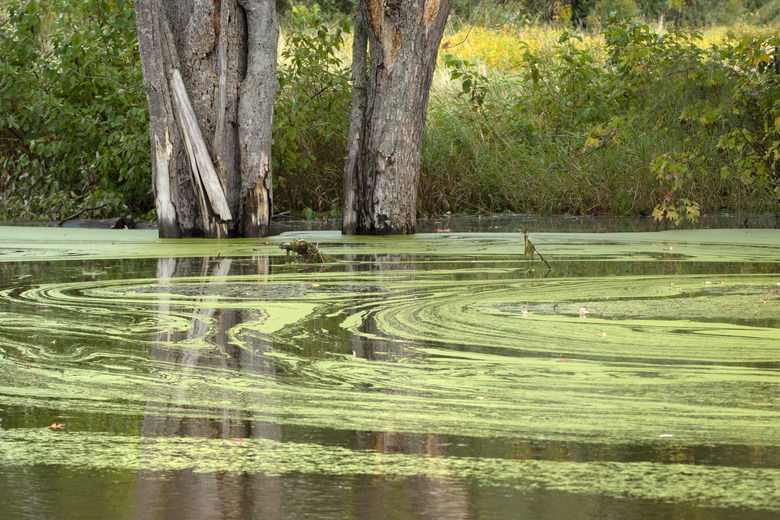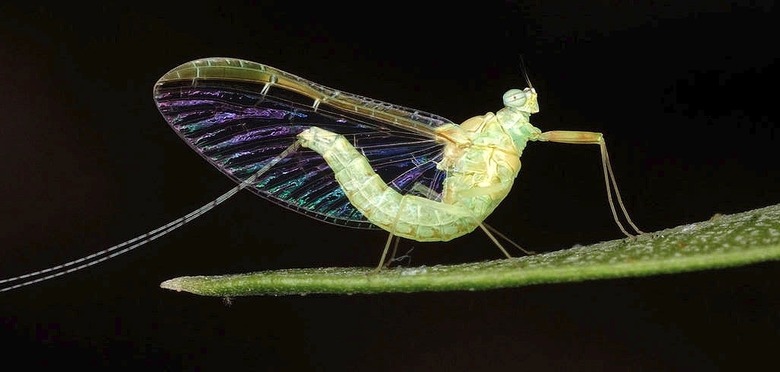Insects That Eat Algae
Algae is a high-quality food source for insects and other aquatic life. Moreover, they function as a factory by converting waste to nitrogen. Insects that eat algae help keep water systems functioning.
Future Foods and the Role of Algae
Future foods are those foods considered the next rung on the food chain. With food insecurity and malnutrition affecting almost 700 million people, alternatives to the simple "cow eats grass, and man eats cow" algorithm evidences that more radical methods are needed, writes the University of Cambridge journal Varsity.
Plant- and animal-sourced food is vulnerable to disease, while so-called future foods are sustainable and highly nutritious. Insects that eat algae fall into that category, but overcoming humankind's reluctance to eat them means that experts must reconfigure how to present them to the public. Some scientists suggest that they can be incorporated into many food products, such as pasta and energy bars.
But which insects dine on algae, get plump with protein and then relieve themselves without harvesting all that nutrition? A visit to a local pond reveals which creatures eat the algae.
Tip
Evaluate the cleanliness of your pond or stream by looking for dragonflies. They are sensitive to pollution and prefer good water quality. If you see mosquitos and leeches, the water system needs TLC.
What Does Algae Eat?
In a pond or stream, algae are busy working. They take in animal waste and convert it to nitrogen before expelling it as oxygen.
Who eats the algae?
Aquatic life and insects fight off snails, frogs and salamanders to dine on algae, because they provide a high-quality food source for many insects.
High-tech farming of these alternative proteins may be one of the answers to combating global malnutrition.
Insects That Eat Algae
A clear-running pond or stream is an active source of nutrition for insects, many of which are busy eating the algae that form above and below the surface. While insects are often considered at the bottom of the food chain, their value to our ecosystem is immeasurable.
- **Mayflies Forage on Stones and Weeds:** In a swiftly moving pond or stream, the adult mayfly is busy
foraging for algae on stones or submerged weeds. Infants start their lives living under rocks and, for their first three years, they eat only algae. The mayfly has only one day of adulthood, when it emerges from the water, molts and lays eggs before it dies. In addition to feeding on algae, the mayfly is food for fish, birds, bats and numerous other forms of wildlife, according to Arkansas State Parks. Sensitive to pollution, mayflies are found in clear streams.
- **Caddisflies:** Of the more than 1,000 types of caddisflies, two types live in
streams. The first type is a carnivore that feeds on prey floating atop the water, while the second type feeds on algae. The larvae feed on algae, while adults cannot ingest nutrition of any type and instead feed on the nectar of flowers. They are vital to the ecosystem in that they are an important link in the food chain. Not only are they a food source for fish, they also filter the algae, reducing the odor and taste problems associated with algae.
- **Water Boatmen:** Living in slow-moving streams, the water boatman sucks juices
from the algae and breaks it down into a liquid form for easy digestion. A human food source in Mexico, the water boatmen are the dessert course.
- **Backswimmers:** Looking like swimmers doing the backstroke, backswimmers eat
both algae and plant life, and they have been observed eating small aquatic creatures. They lay their eggs in algae and return to the surface for air and to feed on other water bugs, preferably water boatmen.
How Algae Protects Itself From Foragers
Algae are classified as plants. Green algae create food through photosynthesis. By making themselves unattractive, they ward off insects and other predators by emitting toxic chemicals.
Warning
Water bugs are a nuisance: They live long lives and grow larger every year. They are predatory and eat fish and other insects as well as algae. They don't mind murky water.

